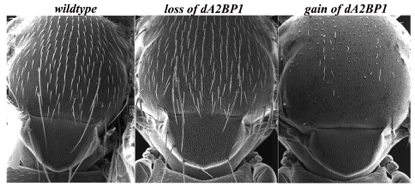lab members working on this project
Jay Prakash Shukla
A2BP1: a novel component of Notch Pathway during Nervous System development in Drosophila.
Spinocerebellar ataxia type 2 is a complex neuronal disorder in which Ataxin2, an RNA binding protein, undergoes polyQ expansion due to mutations in the coding region. The Poly Q expanded Ataxin2 and its partner Ataxin2 Binding Protein1 (A2BP1), another RNA binding protein, are found deposited in large amounts in the cytoplasm of neuronal cells. The implication of this, however, is not well understood. Mutations in A2BP1 result in diseases widely related to nervous system including mental retardation, epilepsy and autism in humans. This project aims to investigate the role of A2BP1 during nervous system development using Drosophila as a model system. A2BP1 is expressed in both central and peripheral nervous systems during Drosophila development. Due to their presence on the adult body surface in the form of bristles, external sensory organs provide a good assay system to study the nervous system development. Loss of function of A2BP1 during development increases external sensory organ number. Conversely, over-expression of A2BP1 leads to loss of bristles. These changes manifest at the level of the number of sensory organ precursors (SOPs) in the wing imaginal disc, suggesting cell fate changes. This is further confirmed as we have observed transformation of bristle-less to companiform sensillia bristles. A series of genetic experiments conducted using Notch, Delta, Enhancer of split, Achaete/Scute, EGFR and Senseless reagents, suggest that A2BP1 is required for normal function of Notch. Biochemical analyses demonstrate that A2BP1 is part of the Su(H) complex in the presence as well as the absence of Notch. Our results suggest that A2BP1 is required to further strengthen the interactions between Notch and Su(H) in the nucleus. Currently, we are employing biochemical approaches to under precise interactions between A2BP1, Notch and Su(H) and the impact of the same on chromatin factors that regulate the expression of target genes.

dA2BP1 is required to restrict the number of sensory organs on the thorax of the fly. Each bristle represents a sensory organ of the peripheral nervous system. Loss of dA2BP1 leads to increased number of sensory bristles and gain of dABP1 causes loss of sensory bristles.